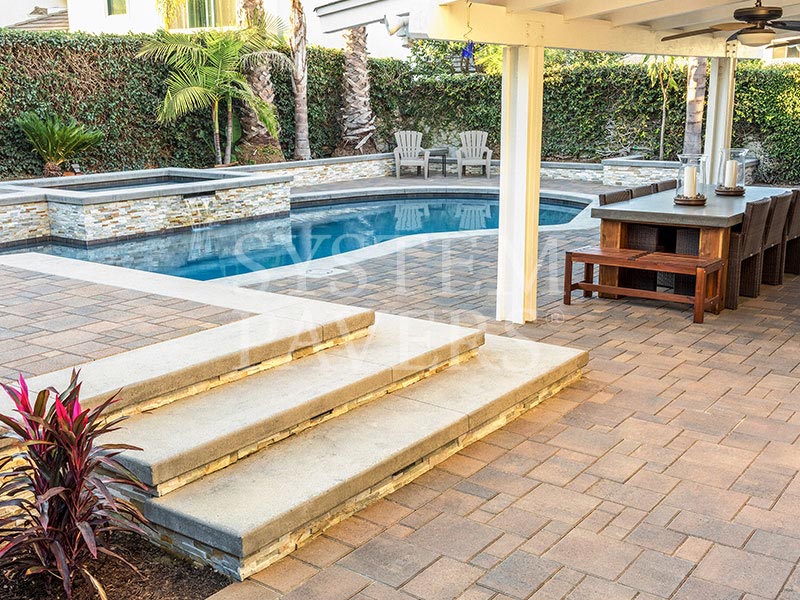
Coping pavers are oftentimes considered the final touch to any outdoor space – both visually and functionally. When it comes to pools, in particular, the materials and styles available can vary, only adding to the custom charm that homeowners strive for in their homes. That said, what exactly are coping pavers for pools – and how do these products work in the long run?
Keep reading this guide to check out the intricacies of coping pavers, including the best materials you can choose, and a brief tutorial on how to install them.
Read as well: Travertine Pavers for a Pool Deck – A Full Guide
What are coping pavers for pools?
Coping pavers for pools – also referred to as pool paver coping – are the edging installed around the perimeter of a swimming pool, regardless of size. Do you know those fancy borders, usually accompanied by steps and subtle waterfalls, that hotel pools tend to have? Well, that’s the idea.
On average, you can expect to pay between $10 and $30 per foot when it comes to paver coping. Its ultimate purpose is to provide a finished edge around the water, which, in turn, contributes to the following:

- Aesthetic enhancement: Coping pavers create a finished edge around the pool, providing a clean and polished look. As mentioned, they can be chosen in various colors, textures, and styles to complement the overall design of the pool area.
- Safety: Pool coping pavers are designed to provide a non-slip surface, reducing the risk of accidents. This is important in areas where people may walk or run around the pool – kids and elderly people especially.
- Water containment: These products are typically installed at the pool’s edge to prevent water from spilling over the deck and into the surrounding area. They help to direct the body of water towards the pool’s drainage system.
- Comfort: Coping pavers often have a rounded or bullnose edge (more on this in a bit), which makes for a comfortable spot for people to sit or lean on while gathering in the pool.
- Protection: They protect the pool’s structure by providing a barrier between the pool shell and the surrounding deck or landscape. This helps prevent damage to the inner wall and the ground adjacent to it.
- Maintenance: Coping pavers can make maintenance easier by preventing erosion problems, as well as debris, dirt, and leaves from getting into the pool every day, as they act as a sort of border.
All of these characteristics make for a good pool coping, so consider them carefully before picking out your product. Also, keep in mind that professional assistance is always a precious suggestion, given how much planning and logistic ordeals are involved in the construction of a swimming pool.
Hardscape experts can help you choose the best material to complement your paving stones. And speaking of materials…
Paver materials for pool edges
Just like anything else in the business, the popularity of paver materials for pools can vary by region and personal preferences. However, several materials are commonly used across the whole country due to their durability, aesthetics, and suitability for humid, slippery environments.
Some of the most popular coping materials for a fiberglass pool, for example, include:
- Travertine: Travertine is a top choice for many pool owners since it is known for its natural beauty, with variations in color and texture that can enhance the pool area’s appearance. Travertine is also relatively cool to the touch, which is comfortable for bare feet in hot weather, and easy to maintain. Click here to read all about this natural stone in poolside applications.
- Concrete: Concrete coping pavers offer versatility in terms of color, texture, and design. As a classic building element, they can be customized to mimic the appearance of natural stone, brick, or other preferred materials. Concrete pavers are also cost-effective and durable, creating beautiful edgings while providing a safe environment for everyone.
- Natural stones: Besides travertine, other natural stones like limestone, granite, bluestone, and sandstone are popular choices, albeit more expensive. This special type of coping paver provides a timeless and elegant look to pool areas – offering durability and resistance to weathering, as well.
- Brick: Brick coping pavers are another classic choice that provides a traditional, rustic appearance and can create a charming and warm poolside atmosphere. However, although bricks are as durable as they can get, they may require more maintenance over time, being prone to cracks and chips from the scorching sun of tropical areas.
Don’t miss: What is the Best Sand for Pavers, After All?
Coping pavers for pools: the most popular styles
Regardless of the material chosen, the next step in your pool construction is the style of edging that’s going to complement its whole design permanently. Below, we’ve set apart a list of four main options that offer their own kind of appeal:
Bullnose edge

Bullnose pavers are very traditional – featuring a smoothly rounded edge on one or more sides and creating a gentle and continuous curve. They are known for their safety, as they eliminate sharp corners and are comfortable for pool users to touch and sit on. This style offers a classic and timeless appearance that’s suitable for various pool designs, particularly those focused on safety and comfort for the entire family.
Square edge

Square-edge pavers, on the other hand, have sharp, right-angle corners and flat, straight edges, providing a clean and contemporary look. Nevertheless, they are versatile and adaptable to a wide range of pool designs and are easy to maintain. These products are often chosen for modern and minimalist designs, imparting a sleek, geometric, and strong visual impact.
Beveled edge

Beveled-edge pavers have an angled edge, typically with a 45-degree bevel, adding subtle decorative details. This style adds elegance and sophistication to the pool coping while ensuring a smooth transition between the pool deck and the pool. This type of coping strikes a balance between a modern appearance and a decorative touch, above all.
Chiseled edge

These pavers showcase irregular, rough-hewn edges that mimic the appearance of weathered natural stone – creating a rustic and weathered look that brings character and texture to the table. Chiseled edges are often chosen for pool designs aiming for a natural or rustic aesthetic, particularly in outdoor settings that embrace a natural landscape or earthy elements. Each chiseled-edge paver is unique, contributing to a one-of-a-kind appearance.
How to install coping pavers for pools
Now that you have the basic knowledge to start planning the swimming pool of your dreams, you may be wondering if it would be possible to tackle such a task on your own. Unless you have considerable experience with previous hardscape projects, the answer is a plain no.
You see, a thorough installation requires handwork and technical knowledge to make it last for a long time. Any miscalculations or improper handling can seriously compromise the structure of your investment, which nullifies the whole point of spending your budget where it’ll reap results. Not only do experts know exactly what they’re doing but come to your place with all the necessary equipment to make it work.
If you’re still eager to try out a DIY approach, though, make sure to get your hands on the majority of the following items (which you can buy or rent at your nearest hardware store):
- Safety glasses or goggles;
- Ear protection (especially if using loud equipment);
- Gloves;
- Dust mask (if cutting pavers);
- Tape measure;
- Chalk line or string;
- Carpenter’s Square;
- Level;
- Stakes and string for layout;
- Shovel;
- Wheelbarrow;
- Pickaxe or mattock;
- Compactor or plate compactor;
- Grading rake;
- Masonry stakes;
- Crushed stone or gravel (for the base);
- Sand (for leveling);
- A paver saw or a wet tile saw (for cutting pavers to fit);
- Chisel and hammer (for finer adjustments);
- Diamond blade for the saw;
- Rubber mallet (for tapping pavers into place);
- Trowel (for spreading sand or mortar);
- Mason’s line (for keeping rows straight);
- Carpenter’s pencils (for marking cuts);
- Joint filler material (polymeric sand or mortar);
- Jointing tool or broom (for finishing joints);
- Concrete adhesive (if using adhesive for extra stability).
Step 1: Prepare the pool deck
Ensure the pool deck is thoroughly prepared by cleaning it of any debris, dirt, or remnants of old coping materials. It should be a smooth, level surface that provides a solid foundation for the new coping pavers.
Step 2: Plan and measure
Before installation, measure the entire perimeter of the pool to calculate the quantity of coping pavers required. Take into account any corners or curves in the design. Plan the layout, ensuring you have a clear vision of how the coping will look when completed.
Step 3: Lay a starter course
Begin by establishing a starter course of coping pavers along one edge of the pool. To ensure straightness and levelness, use a chalk line as a guide. This initial course will serve as the foundation for the rest of the coping.
Step 4: Apply adhesive or mortar
Depending on the specific material of your coping pavers, apply an appropriate adhesive or mortar mix to the pool’s edge where the first course of pavers will be placed – ensuring that the adhesive layer is even and thoroughly covers the designated area.
Step 5: Place and level coping pavers
With the adhesive or mortar in place, carefully position the coping pavers onto it. Press each paver firmly into the adhesive, ensuring they are level both horizontally and vertically. Use a level to verify their alignment.
Step 6: Add subsequent courses and finish
Continue to add subsequent courses of coping pavers, staggering the joints for both structural stability and visual appeal. If your design includes corners or curves, be prepared to adjust and cut pavers accordingly for a precise fit!
Finally, consider installing edge restraints along the outer edge of the coping to prevent pavers from shifting over time – this is an optional, yet recommended step for long-term stability.

In larger pool areas or regions with temperature fluctuations, it’s wise to create expansion joints between the coping pavers using a backer rod and a flexible sealant. This allows for movement without causing cracks.
Learn all about sealing pavers in this article.
After installing the coping, clean any excess adhesive or mortar from the paver surfaces. Optionally, apply a sealant to protect the coping from staining and weathering.
Finally, conduct a thorough inspection to ensure that the coping is level, securely attached, and visually appealing. With these steps completed, you can enjoy your pool with its newly installed coping pavers, enhancing both safety and aesthetics.
Get yourself the best coping pavers for pools at Eagle Pavers!
As a branch of Eagle Stones, our hardscape professionals are ready to help you with anything. We’ve been serving the city of Sarasota and all its surrounding counties for years now – and not only do our clients receive high-quality products from a vast catalog but see firsthand their dream project come true with the best installation services in town.
So don’t hesitate to contact our crew today! We can adorn any outdoor space with the perfect coping pavers for pools, turning it into your private oasis.




